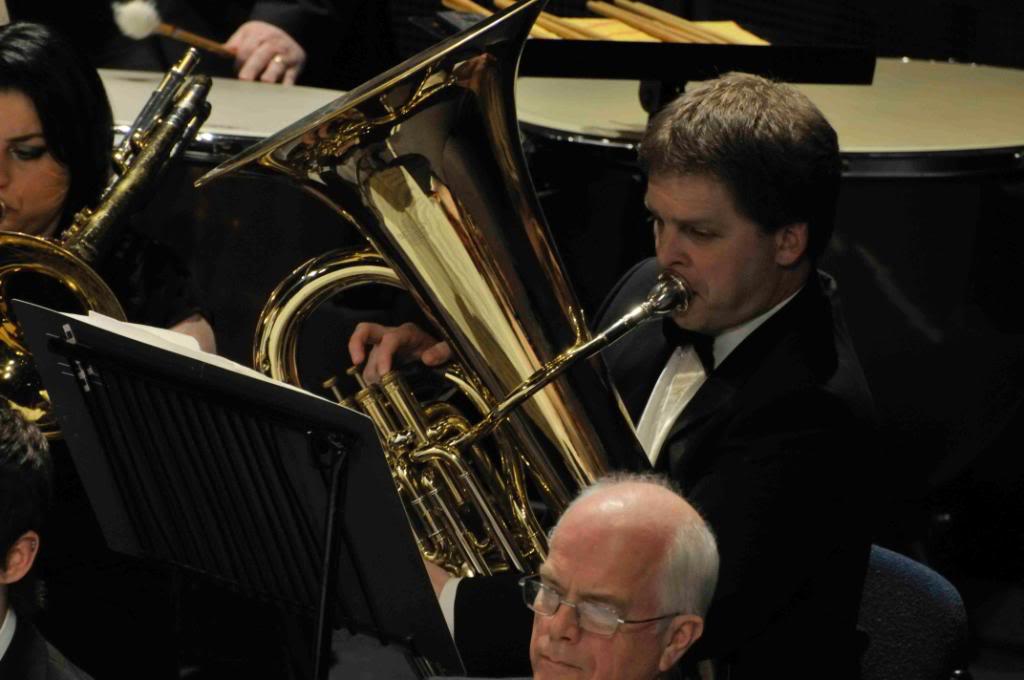On June 14th 2008 I'm going to be the soloist in a performance of the Tuba Concerto by Ralph Vaughan Williams. As well as preparing the piece for performance I've written two sections of the programme: a description of the piece and a short musical biography of myself. Both of these are reproduced below.
Tuba Concerto in F Minor - Ralph Vaughan Williams.
- PRELUDE Allegro moderato
- ROMANZA Andante sostenuto
- FINALE – RONDO ALLA TEDESCA Allegro
Vaughan Williams composed his Tuba Concerto for the golden jubilee of the London Symphony Orchestra in 1954 with the orchestra's own tuba player, Philip Catelinet, as the soloist.
In the programme notes for the occasion Vaughan Williams wrote that the Concerto's form was "nearer to the Bach form than to that of the Viennese School (Mozart and Beethoven)". Consequently, whilst the three-movement piece is relatively short it still demonstrates Vaughan Williams' own harmonic and rhythmic style.
The Prelude is a brisk march that shows off the tuba's agility with little groups of fast notes and scalic passages. The middle section (in compound time) sounds like a grotesque cousin of "Nelly the Elephant" that eventually recapitulates back to the opening march. The movement ends with a florid cadenza that exploits the very highest and lowest registers of the instrument concluding with a series of wide leaps and a slow recall of the main theme.
The Romanza is a piece of lyrical beauty written to demonstrate the vocal quality of the tuba in its high register. The opening melody is in vintage Vaughan Williams folk-song style. The music is more agitated in the middle section where the main theme is ornamented before a climax that leads to a reprise of the meditative mood of the opening.
The Finale is a rondo "alla tedesca" - in the German style - clarifying that it is a traditional rondo in which an energetic main melody (consisting of rocket-like arpeggios and nimble trills) alternates with contrasting episodes. The sleeve notes for the first recording state that "the tuba romps amid the dancing strings, like Falstaff among the fairies in Windsor Forest" while the critic Michael Kennedy calls it "an elephantine romp, humourous and salty". Just as in the first movement, the Finale ends with a virtuosic cadenza rounded off with a wild cascade of sound from the orchestra.
Nicholas Tollervey
Originally from Nottinghamshire, Nicholas commenced his musical studies on the piano, organ and tuba when he was aged twelve. A scholarship resulted in him becoming a principal in the elite National Youth Brass Band of Great Britain and a prize-winning soloist, ultimately leading to a place at the Royal College of Music.

Whilst at the Royal College, he read for an academic (rather than performance related) BMus degree, that included lots of musical analysis, composition, arrangement and historical research. Nevertheless, he won all the tuba performance prizes in each of his three years of study and played as both an orchestral and chamber musician in most of the major concert halls in the UK.
Upon graduation, Nicholas was a founder-member of the Capital Brass Quintet and performed on numerous occasions in concert, on the radio and on television. As a freelance musician he performed in a diverse range of recording sessions: from Ragdoll Productions (for the Teletubbies!), via pop artists signed with major recording labels, to more conventional classical performances.
During this time Nicholas became interested in further academic study and gained Masters' degrees in Philosophy and then Computing, all the while supporting himself by teaching music.
Now living in Towcester, he currently designs and writes software but continues to play at an advanced level, "just for fun".
